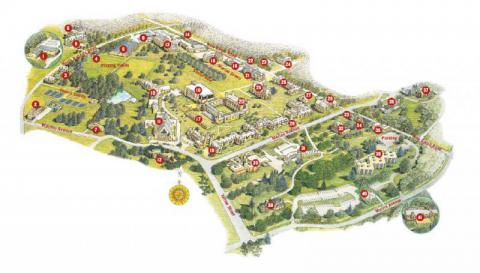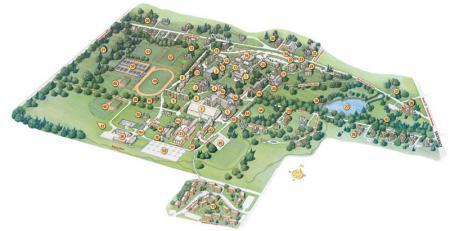January 31, 2015 - 17:22

2:25-2:35
I. coursekeeping
sketch two campus maps on the side board--place your site sits here, please.


on the other board: your metaphor for ecological pedagogy....
Persistence: ecological mindfulness-> opportunism
Celeste: relationship between the migrant worker and the earth
Abby: painting with watercolors (shaping, not controlling…)
asomeshwar: art and the social filter
Purple Finch: teaching a crab to walk forward
tajiboye: the relationship between ecology and education
The Unknown: the colonization of indigo
Caleb: belonging and being lost
Ariel: “solar systems on the back of my hand”
Marian: weaving on a loom
Aquamarine: growth of a tree
Name? Joni?
get back to these momentarily...
first: how far can we get with naming one another? with usernames?
reminder of writing conferences this week,
and your first "web event" by midnight on Monday;
in a bit, I'll put you in groups of 3 to work on these together
(sharing vulnerability): frankly overwhelmed by our brainstorming of
possible ways we might interact more 'ecologically'
(like Pandora, opening the box of troubles!)
grateful for Joni's reminder of the need for limits, for sustainability in our planning.
also clear to me that I didn't have an idea of how to make decisions ecologically--
expect it's really about trying things out, tinkering, making, criticizing the making...
so that's what we're going to do: try out your different suggestions,
then reflect on whether they're working.
for class on Thursday, bring back the short essay by Garzón,
"The Quest for Cognition in Plant Neurobiology"--don't think we'll get to that today...
and read Part I of J.M. Coetzee's book, The Lives of Animals (to p. 69).
Write out a single passage from the book that strikes you--for whatever reason--
and write the reason: I don't understand this/this bothers me/this reminds me of...
whatever-- and we'll do "silent discussion" about these.
I'll explain this on Thursday, but it's a way to get more 'space' and 'silence' in discussion,
which several of you asked for...a way of your starting the conversation,
and my entering 'later' (without my having to hover in the anteroom!)
2:35-2:50
II. speaking of space and silence...look now @ the map of the bi-co
that we've created with the "sites" we've selected-->
What are we leaving out of our picture? What are the edges, what won't we see?
In an essay we didn’t have time to look @ last week, Stephen Greenblatt juxtaposed “wonder”--
the power of an object to stop us in our tracks—with “resonance”—its power to reach out
beyond its formal boundaries, to evoke a larger world. Greenblatt uses the comparison to talk
about museum display, and to critique his own work as a new historicist, who looks always @ the
larger picture, and so neglects the “masterpiece” @ its center--but I think he gives us a useful
spectrum to keep in mind as we re-visit our sites throughout the semester: what is wondrous,
here-and-now; and how does this site reach beyond, invite us to reflect on the world it emerges from and stands in for?
You did a lot of this back-and-forthing in your initial descriptions:
Purple Finch called the bench next to Pensby “a space for my mind to wonder,” to “foreground the background”;
across the valley of death Abby was doing something quite similar: watching the moon, from the American Beech
that breaks up the oaks that make up Senior Row: “I find it fairly easy to think big. I think that the hardest part is not getting lost in it”;
near her, also on a bench on the hill overlooking athletic fields, was Joni;
as well as Persistence and Tajiboye, who are both in the labyrinth, withTajiboye giving the most concrete sensory account:
“The earth that was able to pierce through the gaps of snow felt firm, but firm in the same way that a fruit cake is. Like, rubber.”
More on “the margins” (and of course one of the things that is getting clearer is that there are no margins here…) were
asomeshwar, on the 'Romeo and Juliet' balcony that is on the backside of Goodhart.
Marian @ the spot on the creekbank behind Batten, that reminds her of home;
Celeste on Bryn Mawr’s rugby pitch/football field, which doesn’t appear on the campus map;
The Unknown on the bench in Morris Woods,
Aquamarine in the Collier Atrium (not outside...?),
and me, also in a hiding place, “the pot tree” close to Rockefeller.
on the HC campus,
Ariel chose four stepping-stones near the willow tree overlooking the duck pond-- just borrowing a “hiding space”
that reminded her of “the back of her mom’s closet,” where “silk skirts would tickle her legs as she tried to balance
on top of black stilettos” (again: very detailed, sensory—but the senses are of another place and time!); while
Caleb found an uprooted tree off of the nature trail, and gave us 5 wonderful ever-further-away topographic views:
close up, “the forest seems quite tiny in the midst of Philadelphia’s suburban sprawl,” but from far away you can
see how it’s “situated in a much more rich spattering of woods and city.”
Name?
You’ll return to these each week. This is a great place for you to do some of the creative work that many of you want space to do.
Play with how you present what you are experiencing: Joni (tried? this didn’t work?) to put up a selfy with her tree in focus,
herself out of focus; you can shift focus from close up (like Tajiboye’s “rubbery fruitcake”) to far away (like Caleb’s topography maps),
or cut back and forth, as Abby did, measuring the movement of the moon against the branches…
2:50-3:10
III. I'd asked you to look, for today, @ the images in the Imagining Deep Time exhibit,
as well as Rachel Sussman's photographs of The Oldest Living Things in the World--
and to compare these to our images of the bi-co campuses, as a way of keeping in mind that locating ourselves
HERE is also/always putting ourselves in relationship w/ the larger world in which this one is situated.
Sussman's book includes a quote from Carl Sagan, which I made the epigram for this course:
"Once we lose our fear of being tiny, we find ourselves on the threshold of a vast and awesome universe
which dwarfs—in time, in space, and in potential—the tidy anthropocentric proscenium of our ancestors."
Several of you (who?) are geology majors, so have been grappling for a couple of years now with the
conundrum of deep time--the mind-bending difference between the millions and billions of years of geologic evolution,
as opposed to the centuries and millennia of human civilization. At a faculty seminar a few years ago,
Arlo Weil talked about how extremely difficult it is to grasp the link between the human experience and that of the earth;
Arlo emphasized how hard he found it to think simultaneously about deep time and his own lived experience of time:
his ability to grasp, but not fathom, what constitutes the difference. There is for him a "disconnect," an inability to
"think in parallel" about scales that are so different. [helpful guidelines from Park along these lines...?]
Today's experiment is actually whether art can help us cross that divide--help us "get this" in our gut--
and also help us figure out how to cope with that kick in the gut-->
do all human motivations vanish, when seen from a geological perspective?
"On this time scale, nothing I do matters...nothing I do has an effect."
Alternatively, might such an understanding give us a distanced perspective,
make us less angry, more indifferent to petty human concerns, even bring us to ecstasy...?"
Initial reactions to some of the artwork,
the photographs of oldest living things, art depicting deep time...?
It is the central claim of this course that "The real, material ecological crisis...
is also a crisis of representation. The inability of political cultures to address
environmentalism is in part a failure of narrative." (One answer to Marian's
question, last week, about the paradox of this course: what practical purpose it might have...)
I want us to use the work of Chris Jordan to get @ this.
He's an artist who is pretty magnificent @ "running the numbers":
I used one of his images from Midway: A Message from the Gyre
to mark our move into this second part of the course, on "getting beyond ourselves."
Let's look @ a couple of other images, from his collection "An American Self-Portrait:
Cigarette Butts, Toothpicks, and Paper Bags--these play with some new kinds of
story depicting devices (the reverse of what Caleb did--being astonished by the beauty of the image,
then led in closer, closer, closer until you realize w/ horror what you are seeing close-up....)
3:10-3:20
IV. Loop back to Timothy Morton, who got very short shrift on Thursday, who said that
"The ecological thought must interrogate both the attitude of science, its detached authoritarian coldness;
and the nihilistic, baselessly anthropocentric arguments in the humanties." (I think Jordan's art does this...)
Morton talks about "noir film" as the art form of ecological thought (what's that?)
...only to discover that she or he is implicated in...the shadowy world of irony and difference....
irony insists that there are other points of view that we must acknowledge (16-17).
Ecology is profoundly about coexistence....Human beings are each others' environment (4).
The ecological thought...is a practice and a process of becoming
fully aware of how human beings are connected with other beings (7).
Being a person means never being sure that you're one....treat many more beings
as people while deconstructing our ideas about what counts as people (8).
Nothing exists all by itself, and so nothing is fully "itself." The ecological thought imagines a
multitude of entangled strange strangers...displacement and disorientation...
a radical openness to everything...therefore full of shadows and twilights (15).
the ecological thought must transcend the language of apocalypse...much more pleasurable, far more sociable,
and ever so much more reasonable than we can imagine...living minus Nature, plus consciousness (19)
3:20-3:45
V. in all the time that's left! get into groups of 3 and help each other "think towards" your papers...
this assignment also an act of being vulnerable, by me: don't know how to teach,
to prepare you for this unpredictable world!
including brainstorming how you might represent your ideas in engaging/surprising ways...
THINK ESP. ABOUT AUDIENCE: WHO NEEDS TO KNOW WHAT YOU ARE SAYING?
(me, us, the bi-co ENVS program, your geology teachers...?
several of you spoke of wanting to do projects that reach beyond this class...
this is your first chance to do this...)
I'm going to take The Unknown's suggestion and disappear up the stairs....
